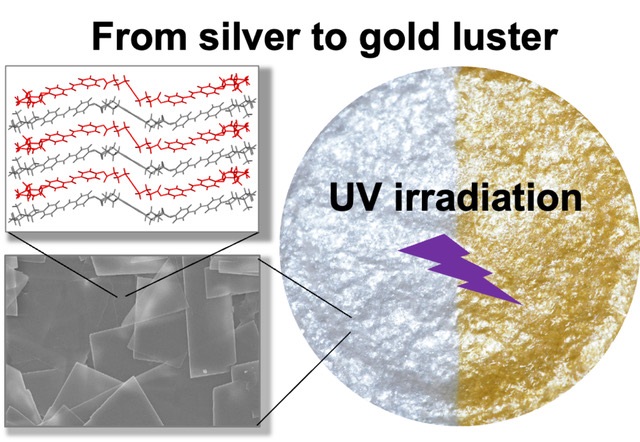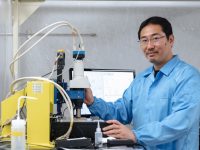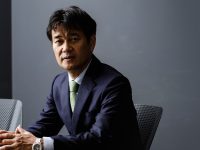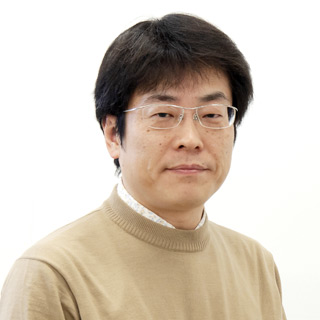Researchers developed a sustainable metal-free material that changes its color under external stimulus
There have been many attempts to create monochromatic metallic materials, but few materials change luster color in response to external stimuli. In a recent breakthrough, researchers from Chiba University have prepared a diacetylene derivative-based metallic luster material that changes from silver to gold under UV irradiation. These findings are expected to find applications in decorative items, printing inks, photomask patterning, UV laser lithography, and cosmetics.

Image title: From silver to gold luster
Image caption: UV irradiation of diacetylene crystals obtained by forming a unique array structure changes the luster from silver to gold.
Image credit: Michinari Kohri from Chiba University
Image license: Original Content
Usage restrictions: Do not use without permission.
Societies of the past and present have given high regard to precious metals like gold and silver. Both metals remind us of nobility and luxury. However, they are quite expensive, which restricts their applications. Therefore, materials with attractive but artificial gold- and silver-like metallic lusters are popular, finding use in jewelry, reflective materials, inks, and cosmetics.
Unfortunately, typical metallic luster materials cause environmental harm, rendering them unsustainable. Thus, scientists are actively searching for metal-free alternatives. In this direction, the research fraternity has examined organics such as thiophene, pyrrole, porphyrin, azobenzene, and stilbene derivatives and found some success in creating materials whose colors can be tuned by external stimuli while maintaining the metallic luster. However, the task still remains challenging.
Recently, a group of researchers from Chiba University, led by Professor Michinari Kohri and Kyoka Tachibana from the Graduate School of Engineering, in collaboration with scientists from Mitsubishi Pencil Co., Ltd., Tokyo University of Science, Keio University, and Yamagata University, has demonstrated the preparation of a metallic luster material that changes color from silver to gold under UV irradiation. Their findings were published in ACS Applied Materials & Interfaces on September 14, 2024.
Highlighting the motivation behind this study, Prof. Kohri says, “Expanding on our earlier findings on biomimetic metallic luster materials, we conducted a targeted search for molecular structures capable of transitioning between silver and gold. This effort resulted in the identification of a novel material with desirable properties.”
In this study, researchers developed diacetylene (DA) derivative-based luster materials incorporating stilbenes via linkers at both ends, denoted as DS-DAn (where n represents the linker carbon number, ranging from 1 to 6). Varying n yielded diverse metallic luster and color change behaviors.
After several innovative experimental trials, the researchers observed that the stacked structure of platelet crystals comprising DS-DA1, the derivative with the shortest linker carbon chain, had a silver look. Its luster notably turned to gold upon UV irradiation, a remarkable external stimulus-based behavior. The team attributed this to the unique crystal structure of DS-DA1 with two coexisting assembled states, revealing that partial topochemical polymerization (a polymerization method performed by monomers that are aligned in the crystal state) of DA within the structure modified its color tone from silver to gold.
The silver luster material developed in this study can express a golden luster selectively in specific areas using only light irradiation. It is also possible to add gradation colors of gold and silver. Thus, it has the potential to be useful in a variety of applications, such as decorative items, printing inks, and cosmetics.
“By eliminating metal components, our innovative material minimizes environmental footprint and weight. Moreover, its suitability for UV laser-based drawing techniques opens up new possibilities for high-end decorative printing. Further exploration of molecular structures may make it possible to express a wider variety of glossy colors,” concludes Prof. Kohri, optimistically.
In summary, this work advances the fundamental science of DA polymerization and unlocks new opportunities for metallic luster materials with desirable properties in photomask patterning and UV laser lithography.
About Professor Michinari Kohri
Michinari Kohri obtained a Ph.D. in Engineering from Tohoku University in 2007. He currently holds the title of Professor at the Department of Applied Chemistry and Biotechnology, Graduate School of Engineering, Chiba University. His research is centered around polymer chemistry, colloid chemistry, and functional materials, with a particular focus on structural colors, biomass upcycling, and soft magnetic materials. He has published over a hundred papers on these topics and is a member of various scientific societies, including The Chemical Society of Japan, The Society of Polymer Science (Japan), and The Japanese Liquid Crystal Society.
Funding:
Michinari Kohri acknowledges the support of the Japan Society for the Promotion of Science (JSPS) KAKENHI (No. JP23H02018), the Transformative Research Areas “Materials Science of Meso-Hierarchy” (No. JP24H01697), and the Shorai Foundation for Science and Technology. Takashige Omatsu acknowledges the support of the JSPS KAKENHI (Nos. JP22H05131, JP22H05138, JP22K18981, and JP23H00270) and the Japan Science and Technology Agency (JST) Core Research for Evolutional Science and Technology program (No. JPMJCR1903).
Reference:
Title of original paper: Silver to Gold Metallic Luster Changes in Stimuli-Responsive Diacetylene Derivatives Uniquely Arranged within Crystals
Authors: Kyoka Tachibana1, Yuki Kojima1, Hyuma Masu1,2, Nobuyuki Ichikuni1, Hikaru Takahashi1, Kota Akiyama3, Kazuki Nakamura3,4, Norihisa Kobayashi3, Shuji Ichikawa5, Yukishige Kondo6, Yuya Oaki7, Jun Matsui8, Shuji Okada9, Takashige Omatsu3,4, Keiki Kishikawa1,4, and Michinari Kohri1,4
Affiliations:
- Department of Applied Chemistry and Biotechnology, Graduate School of Engineering, Chiba University
- Center for Analytical Instrumentation, Chiba University
- Department of Materials Sciences, Graduate School of Engineering, Chiba University
- Molecular Chirality Research Center, Chiba University
- Research & Development Center Shinagawa, Mitsubishi Pencil Co., Ltd.
- Department of Industrial Chemistry, Faculty of Engineering, Tokyo University of Science
- Department of Applied Chemistry, Faculty of Science and Technology, Keio University
- Faculty of Science, Yamagata University
- Department of Organic Materials Science, Graduate School of Organic Materials Science, Yamagata University
Journal: ACS Applied Materials & Interfaces
DOI: https://doi.org/10.1021/acsami.4c14218
Contact: Michinari Kohri
Graduate School of Engineering, Chiba University
Email: kohri@faculty.chiba-u.jp
Public Relations Office, Chiba University
Address: 1-33 Yayoi, Inage, Chiba 263-8522 JAPAN
Email: koho-press@chiba-u.jp
Tel: +81-43-290-2018
Recommend
-

The Quest for High-Energy Neutrinos: Chasing a Complete Theory of the Universe
2024.12.19
-

Navigating Offshore Wind Power Expansion: Nurturing Ocean-based Wind Energy Management Experts through Industry-Academia Partnership
2023.09.28
-

Safeguarding Lifelines: Rapid Restoration of Infrastructure in Earthquake-Prone Japan
2024.10.21


